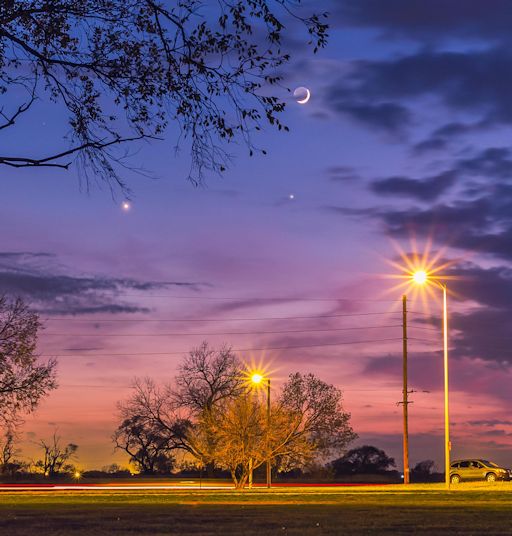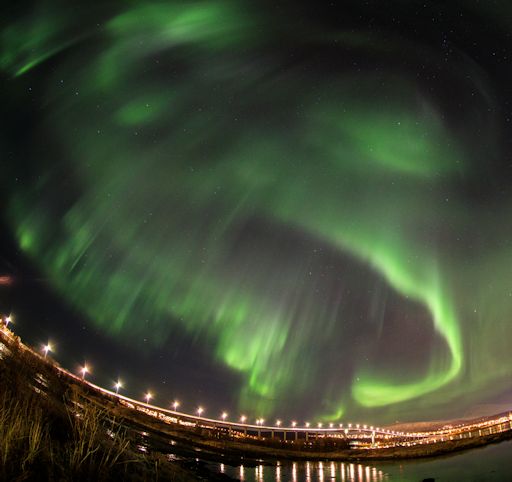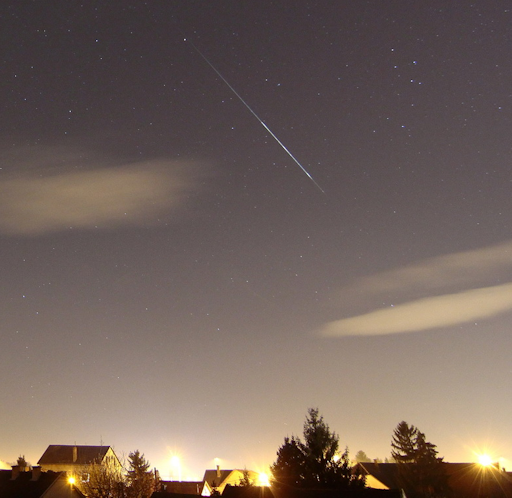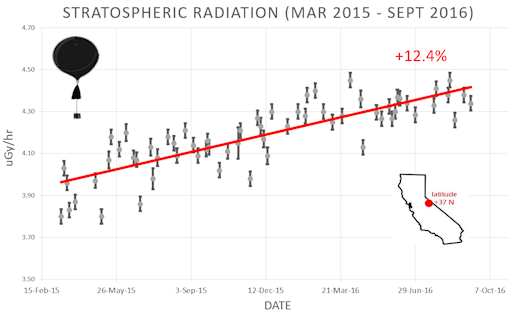Based in Tromsø directly under the Arctic Circle, Marianne's Arctic Xpress offers a comfortable 7 seater minivan for aurora, fjord, whale, and wildlife tours day and night. 100% PASSION and a very high % of finding aurora. Book Now | | | CHANCE OF STORMS THIS WEEKEND: NOAA forecasters estimate a 40% chance of minor geomagnetic storms on Nov. 4th when a solar wind stream is expected to buffet Earth's magnetic field. This is not a major stream of solar wind, like the one that sparked bright lights during the last week of October. Nevertheless, Arctic sky watchers should be alert for auroras on Friday and Saturday nights. Free: Aurora Alerts SUNSET SKY SHOW: Last night, Nov. 2nd, the crescent Moon, Venus and Saturn gathered to form a triangle in the sunset sky. The formation was visible around the world even from brightly-lit urban areas. Jingpeng Liu sends this picture from Lincoln, Nebraska: 
"Our star party began at sunset as the Moon joined Venus and Saturn for the formation of a triangle in the south-west sky," says Liu. "I seized a chance from the clouds and took this picture with a Canon 6D set at ISO 800 for 8s." Sunset photographers, take note of those settings. In the weeks ahead the Moon will circle the sky, ultimately returning to Venus on Dec. 3rd. Instead of Saturn, Mars will form the third vertex of the celestial triangle. Mark your calendar for the next sunset sky show. Realtime Space Weather Photo Gallery UNRULY AURORAS DISOBEY FORECASTS: The forecast for Nov. 2nd called for no auroras. "But here in Tromso, Norway, the auroras ignored the forecast," reports Michael Zawadzki. "The sky erupted for the second night in a row." The luminous outburst was so wide, he needed a fisheye lens to capture it all: 
"The past two nights have been truly remarkable," marvels Zawadzki.
What went wrong with the forecast? It didn't anticipate the interplanetary magnetic field (IMF). On Nov. 1st and 2nd, Earth passed through regions of negative IMF. Lines of magnetic force wrapped themselves around our planet's magnetosphere and pried open a crack, allowing solar wind to pour in and fuel the unpredicted display.
Lesson learned: At this time of year, when dark wintry skies favor visibility, Arctic sky watchers should remain alert for auroras regardless of the forecast. More snapshots of last night's surprise display may be found in the aurora gallery. Realtime Aurora Photo Gallery WATCH OUT FOR TAURID FIREBALLS: Every year in late October and early November, Earth passes through a river of space dust associated with Comet Encke. Tiny specks of debris hit Earth's atmosphere, producing a minor shower of meteors known as the Taurids. Although the shower is minor (typically, it only produces a few meteors per hour) it is nevertheless remarkable. The debris stream of comet Encke is spiced with gravely nuggets that tend to disintegrate as bright fireballs. Karoly Jonas caught this one blazing over the bright urban lights of Budapest on Oct. 31st: 
There are signs that the shower is intensifying as November begins. NASA's network of all-sky meteor cameras has counted more than a dozen Taurid fireballs over the USA in the past few nights.
When should you look? You might see a fireball flitting across the sky any time Taurus is above the horizon. At this time of year, the Bull rises in the east at sunset. The odds of seeing a bright meteor improve as the constellation climbs higher. By midnight, Taurus is nearly overhead, so that is a particularly good time. Note: This meteor shower requires patience. In fact, it's more of a slow drizzle than a shower. From any given place on Earth, fireballs might appear no more often than once every few hours. A drizzle of fireballs, however, is worth observing. So keep an eye on the sky in the nights ahead for Taurids. Realtime Space Weather Photo Gallery
Realtime Airglow Photo Gallery
Realtime Sprite Photo Gallery
Every night, a network of NASA all-sky cameras scans the skies above the United States for meteoritic fireballs. Automated software maintained by NASA's Meteoroid Environment Office calculates their orbits, velocity, penetration depth in Earth's atmosphere and many other characteristics. Daily results are presented here on Spaceweather.com. On Nov. 3, 2016, the network reported 80 fireballs.
(76 sporadics, 3 Northern Taurids, 1)  In this diagram of the inner solar system, all of the fireball orbits intersect at a single point--Earth. The orbits are color-coded by velocity, from slow (red) to fast (blue). [Larger image] [movies] Potentially Hazardous Asteroids ( PHAs) are space rocks larger than approximately 100m that can come closer to Earth than 0.05 AU. None of the known PHAs is on a collision course with our planet, although astronomers are finding new ones all the time. On November 3, 2016 there were 1740 potentially hazardous asteroids. Notes: LD means "Lunar Distance." 1 LD = 384,401 km, the distance between Earth and the Moon. 1 LD also equals 0.00256 AU. MAG is the visual magnitude of the asteroid on the date of closest approach. | | Cosmic Rays in the Atmosphere |
Readers, thank you for your patience while we continue to develop this new section of Spaceweather.com. We've been working to streamline our data reduction, allowing us to post results from balloon flights much more rapidly, and we have developed a new data product, shown here: 
This plot displays radiation measurements not only in the stratosphere, but also at aviation altitudes. Dose rates are expessed as multiples of sea level. For instance, we see that boarding a plane that flies at 25,000 feet exposes passengers to dose rates ~10x higher than sea level. At 40,000 feet, the multiplier is closer to 50x. These measurements are made by our usual cosmic ray payload as it passes through aviation altitudes en route to the stratosphere over California. What is this all about? Approximately once a week, Spaceweather.com and the students of Earth to Sky Calculus fly space weather balloons to the stratosphere over California. These balloons are equipped with radiation sensors that detect cosmic rays, a surprisingly "down to Earth" form of space weather. Cosmic rays can seed clouds, trigger lightning, and penetrate commercial airplanes. Furthermore, there are studies ( #1, #2, #3, #4) linking cosmic rays with cardiac arrhythmias and sudden cardiac death in the general population. Our latest measurements show that cosmic rays are intensifying, with an increase of more than 12% since 2015: 
Why are cosmic rays intensifying? The main reason is the sun. Solar storm clouds such as coronal mass ejections (CMEs) sweep aside cosmic rays when they pass by Earth. During Solar Maximum, CMEs are abundant and cosmic rays are held at bay. Now, however, the solar cycle is swinging toward Solar Minimum, allowing cosmic rays to return. Another reason could be the weakening of Earth's magnetic field, which helps protect us from deep-space radiation. The radiation sensors onboard our helium balloons detect X-rays and gamma-rays in the energy range 10 keV to 20 MeV. These energies span the range of medical X-ray machines and airport security scanners. The data points in the graph above correspond to the peak of the Reneger-Pfotzer maximum, which lies about 67,000 feet above central California. When cosmic rays crash into Earth's atmosphere, they produce a spray of secondary particles that is most intense at the entrance to the stratosphere. Physicists Eric Reneger and Georg Pfotzer discovered the maximum using balloons in the 1930s and it is what we are measuring today. | | The official U.S. government space weather bureau | | | The first place to look for information about sundogs, pillars, rainbows and related phenomena. | | | Researchers call it a "Hubble for the sun." SDO is the most advanced solar observatory ever. | | | 3D views of the sun from NASA's Solar and Terrestrial Relations Observatory | | | Realtime and archival images of the Sun from SOHO. | | | from the NOAA Space Environment Center | | | a proud supporter of science education and Spaceweather.com | | | the underlying science of space weather |  | Find homes for sale in Ocala, Orlando and Tampa with the #1 real estate company in Central Florida Local Realty Service |  | Visit Need An Eitzah for all your questions and forum discussions on Jewish life. | | | These links help Spaceweather.com stay online. Thank you to our supporters! | | 
